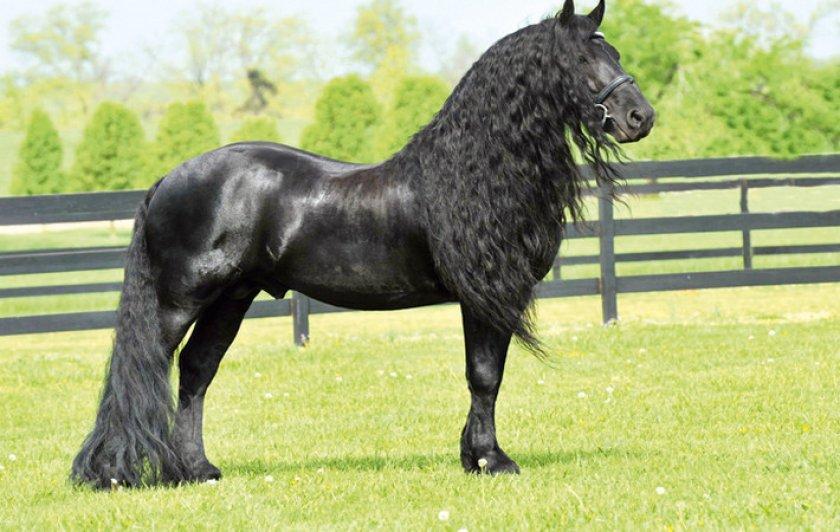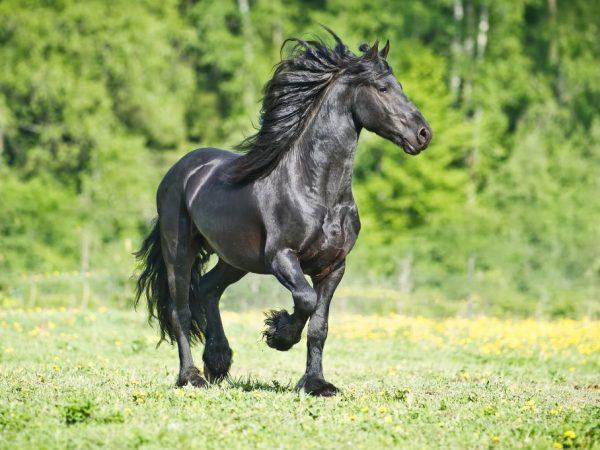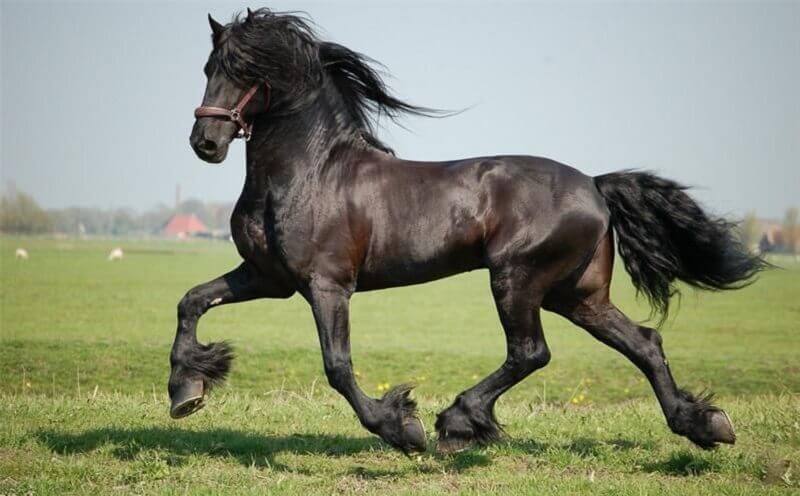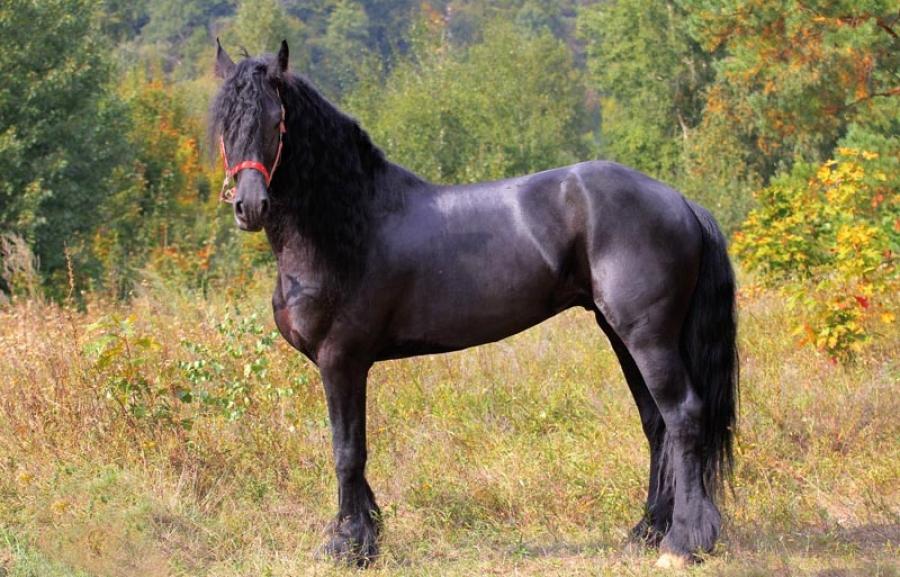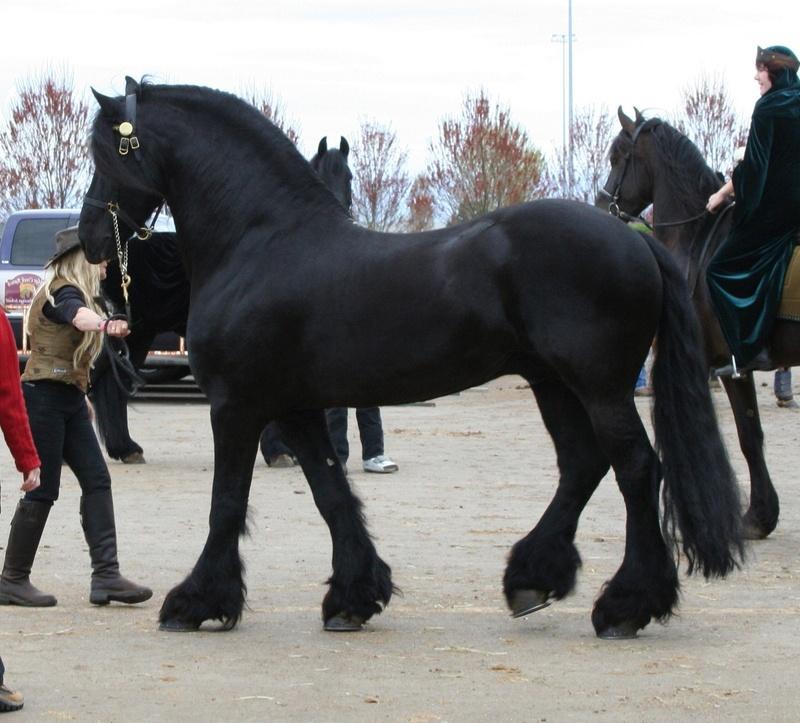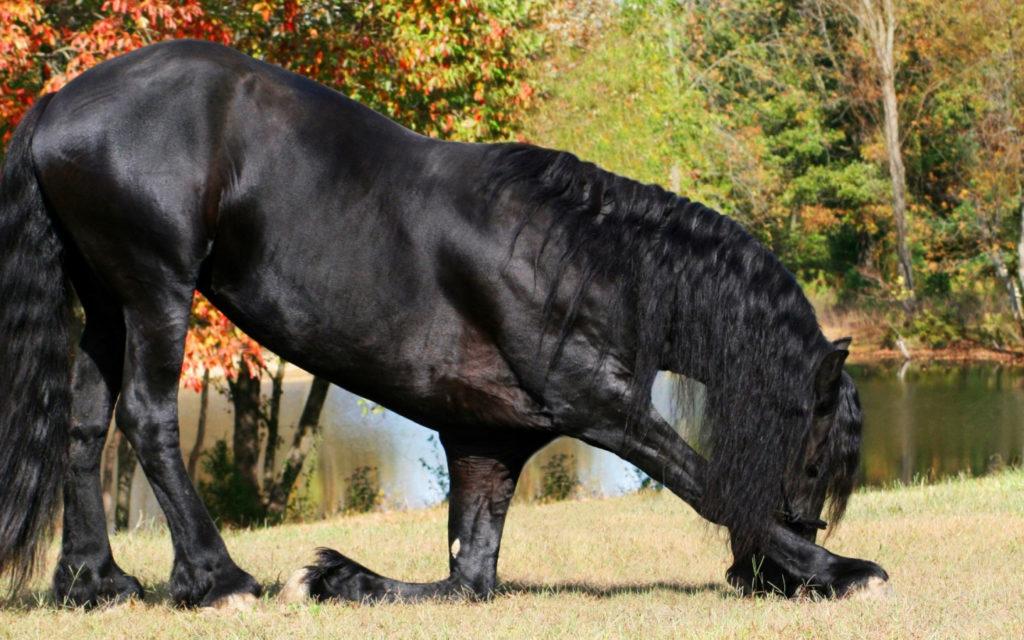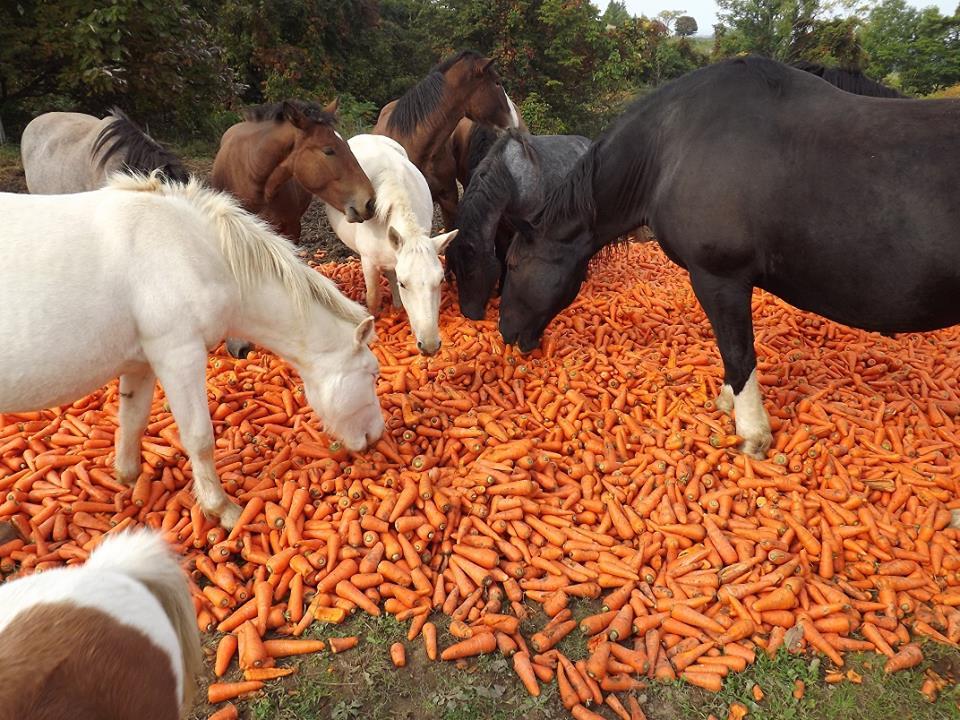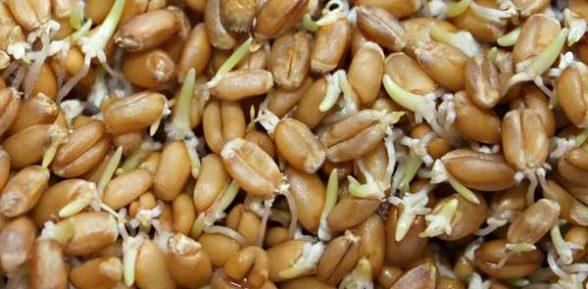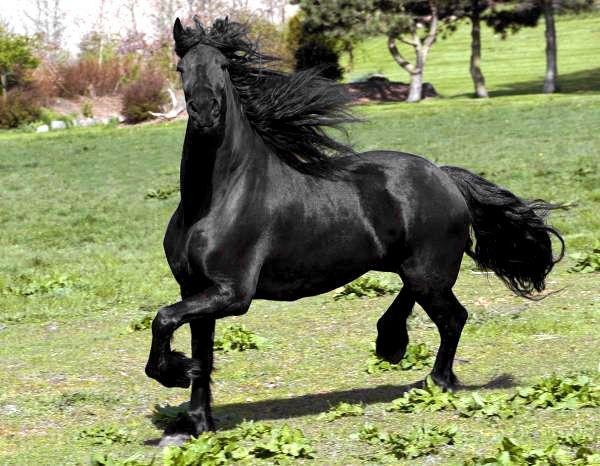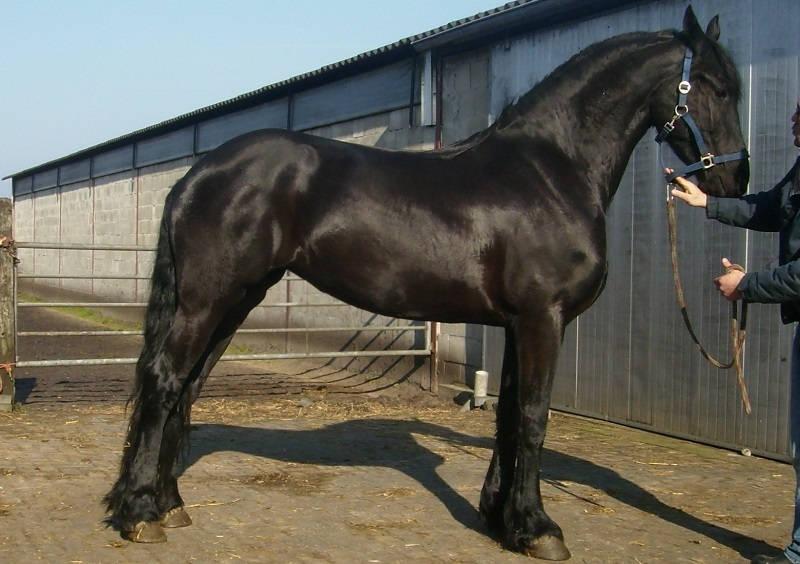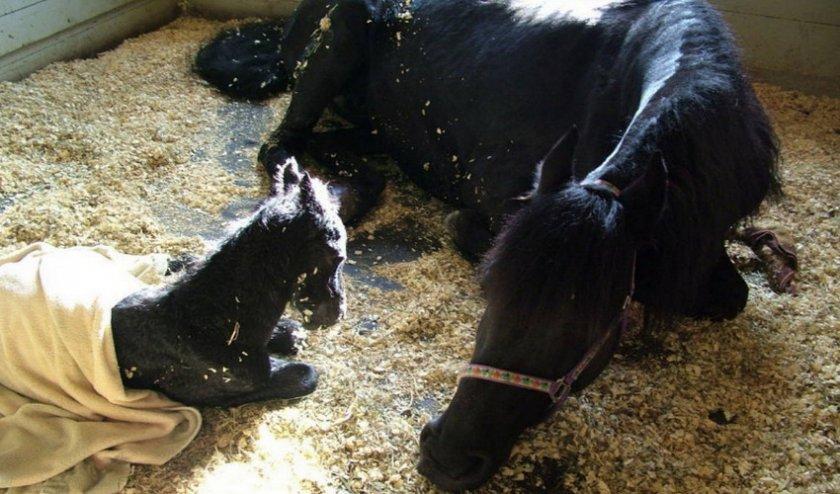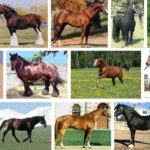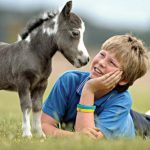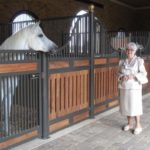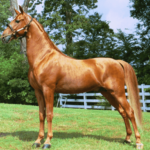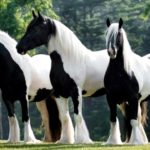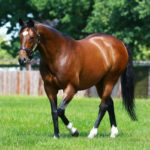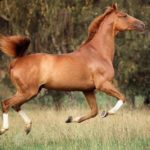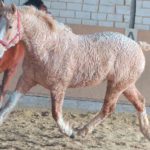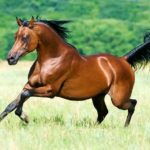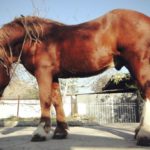Friesian horses are called black pearls or black golds due to their silky coat and smooth arch of the neck. The Dutch breeding species was on the verge of extinction, but now the number of Friesians in the world has increased. The noble exterior aroused the interest of breeders in the breed. The flowing mane and shaggy hooves turn the galloping Friesian horse into the personification of unstoppable force.
- How the breed was born
- Advantages and disadvantages
- Full description and exterior
- Varieties and colors of friezes
- Animal temperament and trainability
- Where are horses used?
- Content Features
- Stable
- Feeding and watering
- Horses
- Pregnant mares
- Body and mane care
- Disease Prevention Measures
- Features of breeding
- Interesting facts about Friesian horses
- Price
How the breed was born
The homeland of Friesian horses is Friesland, a region in the Netherlands. The breed was developed in the 16th and 17th centuries by crossing local cold-resistant draft horses and heat-loving Spanish Andalusians. The ancestors of modern Frisians were not distinguished by grace. They were used as draft animals and for riding. Warriors rode into battle on Friesian horses. Powerful horses supported the weight of a knight in armor.
Medieval Holland was dependent on the economy, trade and military situation in Europe. The appearance and strength of the Frisians varied according to the political situation. Breeders improved the quality of horses using European and Oriental breeds.
During the period of Spanish rule, the Dutch army did not need heavy war horses. Friesians were made easier by crossing with Berber and Andalusian breeds. The result was an agile, universal horse, suitable for war, sports and parades. In the 18th century, the Frisians were gradually replaced by riding breeds. By the 20th century their numbers had declined. But even royal immunity and keeping a stud book did not save Dutch horses from degeneration.
To prevent the Friesians from completely disappearing, and also due to the lack of purebred individuals, they were crossed with other breeds.
As a result, the original medieval grace of the Dutch horses suffered. The legs became shorter and the body more massive. At the end of the 20th century, Europe again became interested in noble breeds. Friesian horses are some of the most beautiful in the world.
Advantages and disadvantages
The Friesian horse is hardy, graceful, of medium height, harmoniously built. The animal walks at a soft gait, comfortable for the rider.
Positive qualities of friezes:
- ceremonial appearance;
- comfortable back curve for sitting;
- agreeableness.
The negative aspects of the Friesian breed relate to the content and use:
- complex diet;
- labor-intensive daily care;
- sensitivity to less-than-ideal living conditions and poor nutrition;
- external data prevails over physical and intellectual abilities.
Friesian horses are beautiful, obedient, but not very intelligent. For team competitions and horse racing, jockeys prefer more maneuverable, low-maintenance breeds. Due to their labor-intensive grooming, Friesian horses are also not suitable for cross-country tour groups. The lush mane, tail and legs are difficult to clean from small forest and field debris.
Full description and exterior
External characteristics of the breed:
- height at the withers – 150-162 centimeters;
- black suit;
- heavy body;
- wide back;
- deep lower back;
- elongated croup;
- curved, high-set neck;
- large elongated head;
- straight profile;
- elongated, pointed, straight ears;
- powerful legs;
- the hind hooves are narrower than the front hooves;
- The legs below the knee joint are covered with long hair.
The athletic Friesian horse adopted the tall stature and lightness of the Andalusian. A thick mane, tail and long hair flowing over the hooves are the distinctive features of the Friesian.
In addition to exterior, the breed standard includes the quality of gait:
- step - four-stroke, uniform;
- trot is a push-pull trot with a long flight phase.
Friesian horses run smoothly, with a carriage gait, raising their legs high. The speed on flat ground is lower than on a thin layer of snow.
Varieties and colors of friezes
Dutch horses are divided into three types of exterior:
- baroque - individuals with a pedigree stretching back to the first representatives of the breed, look noble, are distinguished by a thick mane and high gait;
- athletic - characterized by a short back, dense body, but the small volume of the lungs does not allow participation in races;
- modern - an intermediate type between light sporty and powerful baroque.
The standard color of friezes is black. Sometimes females have a white mark on their forehead - a “star”, not exceeding 3 centimeters in diameter. For males, inclusions are unacceptable.
White or red foals are born as a result of mixing the Friesian breed with the Oriental or American breed. A light shade with a gray tint is obtained by crossing with an Arabian horse. Mixed-breed Appaloosa foals look like brown-haired Friesians.
Animal temperament and trainability
Friesian horses are intelligent and adapt to the rider. The breed is best suited for learning to ride from scratch. Frisians are energetic and balanced, not afraid of loud sounds and crowds. They can be trained in different types of gaits. The phlegmatic nature of the Dutch and the expressiveness of the Spanish ancestors were combined in the sanguine temperament of the Frisians.
Where are horses used?
The road to sports is not closed to Frisians, although handsome men are more often in demand in the entertainment sector. Areas of use:
- urban tourism;
- driving;
- circus art;
- event industry.
Friesian horses are bought for keeping in private stables and riding. Majestic handsome men are harnessed to pleasure carriages and carriages for special occasions.
Content Features
For the well-being of the Frisians Horses need a balanced diet, cleanliness and warmth in the stall.
Stable
Favorable conditions for friezes:
- temperature – 16-20 degrees all year round;
- ventilation, fresh air;
- no drafts.
The size of the stall depends on how much time the horse spends in it.Breeders sometimes set up two places - a winter one, 3x4 meters, and a summer one, 3x2.5 meters.
Feeding and watering
The Friesian horse's menu consists of grass, grain, vegetables and minerals. Elite breed cannot be fed feed for large livestock. The finished mixture contains substances that cause digestive upset. The daily intake is calculated individually based on the horse’s weight and physical activity.
Seasonal feeding schedule for friezes:
- 3 times a day in winter;
- 2 times a day in summer.
Feed is given at the same time of day and evening. Feeders and drinking bowls are installed at horse chest level. Dishes are washed daily and disinfected once a month. Stationary automatic drinking bowls will provide animals with round-the-clock access to clean water.
Horses
Composition of feed for Friesian stallions and mares of all ages:
- bran;
- wheat;
- corn;
- whole oats;
- crushed barley;
- carrot;
- potato;
- raw or boiled beets;
- salt.
Feeding order:
- roughage - hay, grass;
- juicy vegetables;
- grain crops.
Perennial grasses are added to the hay. A healthy food for Frisians is muesli. If there are not enough vitamins and minerals in the diet, animals eat soil, sand, and lick whitewash.
Pregnant mares
Pregnant Friesian mares need vitamins A, B, E, as well as calcium and phosphorus. Add to the diet:
- corn;
- silage;
- cake;
- sprouted grain.
In the summer, mares are allowed to pasture for 6 hours a day. They need to be given more carrots at any time of the year.
Body and mane care
The mane, tail and wool brushes on the hooves are the pride of the Frisians, so the appearance of the animals is carefully looked after. Dutch horses are never clipped, otherwise their appearance loses its greatness. Daily care includes:
- combing the mane and tail with a comb;
- cleaning wool with a scraper.
In the hot summer, horses are given a warm shower. Cold water is contraindicated for friezes, as are drafts. With the first cold weather, water treatments are canceled. The mane and tail are washed with shampoo once a week. Coarse horsehair is easier to comb using conditioner. The product is applied to the mane and tail every 2-3 days.
Disease Prevention Measures
Friezes are sensitive to changes in temperature, diet, and toxins.
How to keep animals healthy:
- Bring to the veterinarian for a medical examination every six months;
- follow the vaccination schedule;
- monitor behavior;
- independently examine teeth, hooves, eyes and ears;
- drive away worms every six months;
- in summer, treat wool with insect repellents;
- Maintain cleanliness in stalls.
Frisians are vaccinated against the following diseases:
- rabies;
- tetanus;
- flu;
- herpes;
- encephalomyelitis.
Symptoms of problems with the oral cavity: drooling, the horse chews on one side of the jaw, refuses solid food. Frisians' teeth grow throughout their lives. Difficulty chewing solid food occurs due to malocclusion or inflammation of the gums.
During a walk, you need to make sure that the Friesian horse does not eat unknown berries and plants. Signs of poisoning include refusal to eat, diarrhea and lethargy.
Features of breeding
The probability of pregnancy occurring naturally in Friesian mares is 15%. Artificial insemination is used for breeding. The mating season of Frisians lasts from March to June. The gestation period is 11 months. Childbirth is difficult, often with a caesarean section.
Interesting facts about Friesian horses
The majestic Dutch horses have left their mark on the history of horse breeding and the world:
- by order of German Emperor Wilhelm I, in the 18th century, Frisian running competitions were held - “Royal Whip Day”;
- Since 1985, Dutch horses have been harnessed to Queen Elizabeth's carriage at the annual opening ceremony of the British Parliament;
- In Britain, a long-living horse became famous, which lived for 50 years. On average, representatives of the Friesian breed live 25 years;
- Friesians are fabulous horses. They are harnessed to princess carriages at Disneyland;
- Friesian horses have counterparts - Fell ponies. They have the same brushes on their hooves and long manes.
Owners can let Friesians out onto overgrown lawns. Animals can handle green growth better than a lawnmower. For good work and obedience, the Dutch beauties are pampered with their favorite treat - sugar.
Price
The price depends on the availability of pedigree and the country of sale. The main supplier of the Friesian breed is the Netherlands. The minimum price for a horse from a Dutch nursery is 10 thousand euros, excluding delivery.
There are few equestrian organizations in Russia specializing in breeding Friesians. KSK Svetozar and Kartsevo are well known in the Moscow region. You can view applicants on the websites of the complexes. How much the stallion or mare you like costs needs to be clarified separately when purchasing.
The frieze can be purchased from a private seller through online message boards. Prices for titled horses with a pedigree on purchase and sale sites range from 350 thousand to 1.5 million rubles. Owners highly appreciate the sporting achievements and abilities of their pets.

